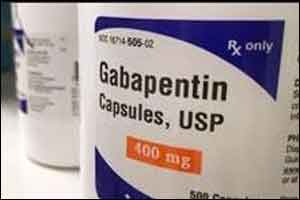- Home
- Editorial
- News
- Practice Guidelines
- Anesthesiology Guidelines
- Cancer Guidelines
- Cardiac Sciences Guidelines
- Critical Care Guidelines
- Dentistry Guidelines
- Dermatology Guidelines
- Diabetes and Endo Guidelines
- Diagnostics Guidelines
- ENT Guidelines
- Featured Practice Guidelines
- Gastroenterology Guidelines
- Geriatrics Guidelines
- Medicine Guidelines
- Nephrology Guidelines
- Neurosciences Guidelines
- Obs and Gynae Guidelines
- Ophthalmology Guidelines
- Orthopaedics Guidelines
- Paediatrics Guidelines
- Psychiatry Guidelines
- Pulmonology Guidelines
- Radiology Guidelines
- Surgery Guidelines
- Urology Guidelines
Gabapentin co-use may increase risk of fatal opioid overdose

Co-prescription of the anticonvulsant gabapentin is associated with an increased risk of opioid-related death in people who are prescribed opioid painkillers, according to a new study published in PLOS Medicine.
Gabapentin is often used together with opioids to treat chronic pain, but both drugs have been shown to suppress breathing, a potentially deadly side-effect. Additionally, gabapentin use may also increase the amount of opioid absorbed by the body, effectively increasing the opioid dose.
In a case-control study among people who were prescribed opioid analgesics in Ontario, Canada, Dr. Tara Gomes of the University of Toronto, Canada, and colleagues, compared 1,256 opioid users who died of an opioid-related cause (cases) with 4,619 matched controls who also used opioids, but did not die of an opioid-related cause during the study period. Overall, 12.3% of cases (155 of 1,256) and 6.8% of controls (313 of 4,619) were prescribed gabapentin in the prior 120 days. After adjusting for additional risk factors, the authors found that the combination of gabapentin and opioid exposure was associated with a 49% higher risk of dying from an opioid overdose than opioid use alone (adjusted odds ratio 1.49; 95% confidence interval 1.18 to 1.88, p<0.001).
The authors caution that this study was limited to a population of individuals eligible for public drug coverage in Ontario, which disproportionately represented low-income neighborhoods. Additionally, the study could not assess drug adherence or account for drugs obtained outside the government reimbursement system (e.g., cash payments or illicit purchases). As with all observational studies, unmeasured confounding may influence the findings, in particular confounding by indication (for example, if pain from more severe underlying illness were a reason for gabapentin co-prescription). However, a sensitivity analysis found no additional risk of opioid-related death for patients co-prescribed opioids and nonsteroidal anti-inflammatory drugs, suggesting that this potential drug-drug interaction is specific to opioids and gabapentin.
"Clinicians should consider carefully whether to continue prescribing this combination of products, and when deemed necessary, should closely monitor their patients and adjust opioid dose accordingly."
For more details click on the link: http://dx.doi.org/10.1371/journal.pmed.1002396

Disclaimer: This site is primarily intended for healthcare professionals. Any content/information on this website does not replace the advice of medical and/or health professionals and should not be construed as medical/diagnostic advice/endorsement or prescription. Use of this site is subject to our terms of use, privacy policy, advertisement policy. © 2020 Minerva Medical Treatment Pvt Ltd